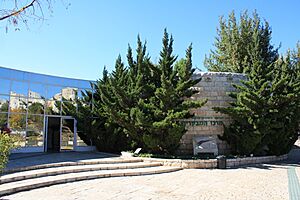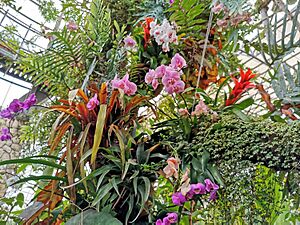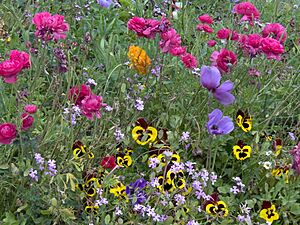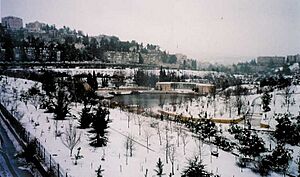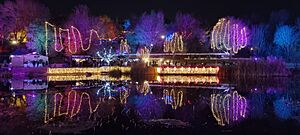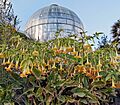Jerusalem Botanical Gardens facts for kids
| הגן הבוטני האוניברסיטאי ירושלים | |
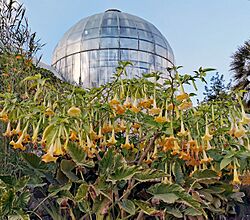
The tropical conservatory, Jerusalem Botanical Gardens
|
|
| Established | 1988 |
|---|---|
| Location | Yehuda Burla St 1, Nayot Jerusalem, Israel |
| Type | botanic garden |
| Collection size | 6,400 species |
The Jerusalem Botanical Gardens (JBG) is an amazing place in Jerusalem, Israel. It's a huge garden where you can learn all about plants! It's also a center for studying plants and teaching people about them.
This garden is the biggest botanical garden in Israel. It has over 6,000 different kinds of plants from all over the world. These plants are grouped together by where they naturally grow. You can find plants from Australia, South Africa, Europe, North America, and even parts of Asia and the Mediterranean.
The garden is located in Nayot, which is on the edge of the Givat Ram campus of the Hebrew University of Jerusalem. It first opened to the public in 1985. It took over from an older garden, the National Botanic Garden of Israel on Mount Scopus, which is still around today.
Contents
History of the Gardens
Starting the First Garden
Plans for Israel's very first National Botanic Garden began way back in 1926. A plot of land was bought on Mount Scopus. Alexander Eig, who was in charge of the Botany Department at the Hebrew University, designed this garden. He wanted it to show plants from all over the Land of Israel, from Mount Lebanon down to the desert. Planting started in 1931. This first botanical garden on Mount Scopus was also the original home of the Biblical Zoo.
Building the New Garden
In 1948, during a war, it became hard to get to Mount Scopus and the university campus. So, people decided to create a new Botanical Garden. This new garden, which is the one we are talking about, was built near the Jewish National and University Library. It was on the new campus of the Hebrew University in Givat Ram, in western Jerusalem.
The new Botanical Garden opened in 1954. It had a special collection of conifers, which are trees like pines and spruces. In 1962, a rocky hill in the garden was planted with conifers from North America. That same year, Michael Avishai became the scientific director. Many of the trees grew from seeds he had collected himself.
Growing and Opening to the Public
For a while, getting enough money was a big problem for the garden. But in 1975, a group called the Society of Friends of the Botanical Gardens was created. This helped the garden become a joint project between the university, the Jerusalem Municipality, and the Jewish National Fund. A group of scientists was chosen to guide the garden, and a famous architect named Shlomo Aronson planned its layout.
In 1981, the Garden Association was formed, and a board was put in charge. Finally, the garden opened to the public in 1985. In 1994, it became separate from the Hebrew University. Since 1996, the Botanical Garden Association has managed it.
Some important additions to the garden include a tropical conservatory, which is like a giant greenhouse, built in 1986. The South Africa section was added in 1989. In 1990, the Hank Greenspan Entrance Plaza, the Dvorsky Visitors’ Center, and a restaurant were opened.
Plant Collections
The Jerusalem Botanical Gardens is the largest botanical garden in Israel and the Middle East. It has a huge collection of living plants, with over 6,400 different kinds. The garden covers 30 acres. It shows off plants from many places like Australia, South Africa, Europe, North America, Southwest and Central Asia, and the Mediterranean.
Japanese Section and Bonsai Trees
The garden has a special Japanese section. This area is home to more than 150 bonsai trees. This is the largest collection of bonsai trees in one place anywhere in the world! A new pagoda is being built in the garden. It will be a special spot for the garden's Japanese plants. The pagoda was designed in Japan and arrived in pieces that were put together right there in the garden.
Bible Path
There's a 500-meter long "Bible Path" in the garden. This path is planted with many of the 70 types of plants that scientists believe are mentioned in the Bible. It's a cool way to see plants from ancient times.
Wildlife in the Garden
Birds
If you love birds, you'll enjoy the gardens! People who watch birds have seen 46 different kinds of birds visiting the Gardens throughout the year. It's a great spot for birdwatching.
Protecting Endangered Plants
One of the main goals of the garden is to create a living gene bank. This means they collect and grow endangered plants from Israel and the surrounding region. By doing this, they help protect these rare plants from disappearing forever.
Fun Events
Winter Lights Festival
Every year in December, the Jerusalem Botanical Gardens hosts the Winter Lights Festival. This event happens around the time of Hannukah and Christmas. The festival lights up a 700-meter path with more than 2.5 million tiny LED lights. It's a truly magical sight! Besides the amazing lights, there are also performers in costumes, yummy food vendors, and other fun activities.
See also
 In Spanish: Jardín Botánico de Jerusalén para niños
In Spanish: Jardín Botánico de Jerusalén para niños
- List of botanical gardens in Israel
- National Botanic Garden of Israel
- Wildlife of Israel
- Tourism in Israel
Images for kids


